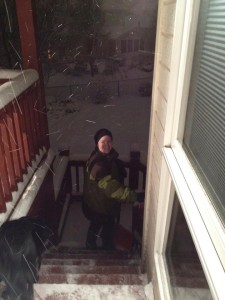Have no fear — the Little House on the Prairie museum site is safe!
At the kind invitation of museum director Michelle Martin, I took an overnight trip to Independence, Kansas, to present about the Wilder Weather of Laura’s books! I gave the presentation twice through the day, for about 45 minutes each time, to an audience of adults and children of all ages (not to mention one persistent wasp!). We discussed events ranging from the tornado in These Happy Golden Years, to the prairie fires in Little House on the Prairie, to the droughts in On the Banks of Plum Creek and The First Four Years, to the signature information on blizzards and chinooks from The Long Winter. I had a blast presenting there, and Michelle did a great job organizing the event and taking care of her speakers and guests!

(Photo courtesy of Michelle Martin)
I also had the chance to see the LHOTP site for the first time. What struck me the most was the landscape. In Laura’s book, the Kansas prairie is wide open, with nary a tree in sight except for a few along the creek bottoms. The land is a great circle of grass from horizon to horizon. Now, trees interrupt the landscape, turning the wide-open prairie into a patchwork of somewhat open fields instead.
Why the change? Aren’t we humans known for cutting down trees when we move in, rather than adding them?
Not in the Great Plains.
There are a few factors that have resulted in an increase in trees over the last 150 years. The first reason goes back to a topic I covered in my talk: prairie fires. Before the area was widely settled, naturally-sparked fires (usually from lightning strikes) burned freely across the prairie, especially in the early spring when lightning is on the increase and grass hasn’t yet greened up for the season. Other fires were set by Native Americans, again usually in the early spring before green-up, to burn off the old, dead grass and allow fresh growth to attract animals. When white settlers arrived and built permanent structure, they were less inclined to favor fires threatening their homes and businesses. So, policies of fire suppression arrived in the late 19th century. Many ranchers still burn their grounds in the spring in Kansas, but areas that are more dedicated to farming or are near more settled areas are not burned. This allows the brushy undergrowth that used to burn away every few years to grow up into trees and scrub.
A second factor in the increase of trees dates back to the Dust Bowl era. Soil conservationists learned a hard lesson, especially on the High Plains (from the Texas and Oklahoma panhandles through eastern Colorado, western Kansas, western Nebraska, and the western Dakotas), that plowing up all the land and stripping root structures from the ground allowed the loose soil to be lifted by the wind, creating the famous dusters or “black blizzards“. The scientists learned that building a row of trees every mile or so would decrease the effect of the wind in the lee of the trees, essentially slowing down the wind and also providing a root structure to hold down the soil. Thus, shelterbelts were born, and those belts continue to impact the landscape across the Plains. They provide a number of benefits beyond soil conservation, including increased habitats for animals and shelter from blowing snow, but they have also changed the look of the land from Laura’s day.
The third factor is much simpler: people tend to plant trees around their homes and towns, to break the wind and provide shade. Pa did it on the homestead near DeSmet, and thousands of others have done the same.
The result is a much more treed landscape now than what used to exist in the beginning of settlement across just about all of the Great Plains region. Many people enjoy the trees, many do not, but either way, they are here to stay, and the great circle of grass that Laura saw is now elusive.
P.S. On my trip to Independence, I stayed at the Apple Tree Inn and ate dinner at Uncle Jack’s. I’d recommend both to anyone else staying in the area for a Laura visit (though Uncle Jack’s is more of an adult place than a family place, being a bar and grill).

